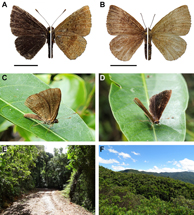Abstract
Petrocerus catiena is a rarely observed Riodinidae butterfly, known from a few specimens from two locations in Serra do Mar (Atlantic Forest) in the Brazilian state of Rio de Janeiro. This species was listed as “Endangered” in the Brazilian Red List due to its small area of occupation and isolated populations under strong anthropogenic pressure. Based on scientific collections and citizen science data, the present study provides information about new geographic records of P. catiena and its perspectives on conservation. A total of 19 specimens of P. catiena were found in six public / private collections, as well as six photograph records of live specimens from citizen science reports. A recent photograph from a locality in the state of Espírito Santo (southeastern Brazil) resulted in an increase in both the extent of occurrence and the area of occupation estimates of P. catiena, implying a possible change in its conservation status. Besides providing new geographical information for a little-known species, the present study also highlights the importance of citizen science in contributing to the knowledge of threatened species and their conservation assessments.
References
- Bachman S., Moat J., Hill A. W., De La Torre J. & Scott B. 2011. Supporting Red List threat assessments with GeoCAT: geospatial conservation assessment tool. ZooKeys 150: 117–126. https://doi.org/10.3897/zookeys.150.2109
- Bart Coppens. 2023. Rarest butterfly I EVER Saw!!!!! (Petrocerus catiena). Available from: https://www.youtube.com/watch?v=1UZL0ZS2-jg (Accessed 23Jun. 2023).
- bettinadungs. 2023a. Petrocerus catiena. iNaturalist observation. Available from: https://www.inaturalist.org/observations/71753163 (Accessed 23 Jun. 2023).
- bettinadungs. 2023b. Petrocerus catiena. iNaturalist observation. Available from: https://www.inaturalist.org/observations/169852849 (Accessed 23 Jun. 2023).
- bettinadungs. 2023c. Petrocerus catiena. iNaturalist observation. Available from: https://www.inaturalist.org/observations/169853249 (Accessed 23 Jun. 2023).
- Callaghan C. J. 1979. New genus and a new subspecies of Riodinidae from Southern Brazil. Bulletin of the Allyn Museum 53: 1–7.
- Fontaine A., Simard A., Brunet N. & Elliott K. H. 2022.v Scientific contributions of citizen science applied to rare or threatened animals. Conservation Biology 36(6): e13976. https://doi.org/10.1111/cobi.13976
- Freitas A. V. L., Marini-Filho O. J., Mielke O. H. H., Casagrande M. M., Brown Jr. K. S., Kaminski L. A., Iserhard C. A., Ribeiro D. B., Dias F. M. S., Dolibaina D. R., Carneiro E., Uehara-Prado M., Romanowski H. P., Emery E. O., Accacio G. M., Rosa A. H. B., Bizarro J. M. S., Silva A. R. M., Guimarães M. P., Silva N. A. P., Braga L. & Almeida G. 2018. Petrocerus catiena (Hewitson, 1875), pp. 176–178. In: Livro vermelho da fauna brasileira ameaçada de extinção: Volume VII - Invertebrados. (Instituto Chico Mendes de Conservação da Biodiversidade org.). Brasília, ICMBio, 4162 pp.
- Freitas A. V. L., Rosa A. H. B., Kaminski L. A. & Silva-Brandão, K. L. 2023. Systematic Position, Immature Stages, and Geographic Distribution of Glennia pylotis (Godart, 1819) (Lepidoptera: Papilionoidea: Pieridae). Neotropical Entomology 52(4): 709–717. https://doi.org/10.1007/s13744-023-01044-2
- Greve R. R., Callaghan C., Kaminski, L. A. & Freitas A. V. L. 2013. The rediscovery of Joiceya praeclarus Talbot 1928 (Lepidoptera: Riodinidae), more than 80 years after its description. Journal of the Lepidopterists Society 67: 56–57. https://doi.org/10.18473/lepi.v67i1.a7
- gmagnago. 2023. Petrocerus catiena. iNaturalist observation. Available from: https://www.inaturalist.org/observations/145495043 (Accessed 23 Jun. 2023).
- IUCN 2012. IUCN Red List Categories and Criteria: Version 3.1. Technical Report, IUCN Species Survival Commission. IUCN, Gland, Switzerland and Cambridge, UK.
- IUCN Standards and Petitions Committee 2022. Guidelines for Using the IUCN Red List Categories and Criteria. Version 15.1. Prepared by the Standards and Petitions Committee. Available from:https://www.iucnredlist.org/resources/redlistguidelines (Accessed 2 Apr. 2023).
- Kaminski L. A., Mota L. L., Freitas A. V. L. & Moreira G. R. 2013. Two ways to be a myrmecophilous butterfly: natural history and comparative immature-stage morphology of two species of Theope (Lepidoptera: Riodinidae). Biological Journal of the Linnean Society 108(4): 844–870. https://doi.org/10.1111/bij.12014
- Kaminski L. A., Soares G. R., Seraphim N., Wahlberg N., Marini-Filho O. J. & Freitas A. V. L. 2015. Natural history and systematic position of Rhetus belphegor (n. comb.) (Lepidoptera: Riodinidae), an endangered butterfly with narrow distribution in Southeast Brazil. Journal of Insect Conservation 19: 1141–1151. https://doi.org/10.1007/s10841-015-9829-7
- Mielke O. H. H. & Casagrande M. M. 2008. Petrocerus catiena (Hewitson, 1875), pp. 447–448. In: Livro Vermelho da Fauna Brasileira Ameaçada de Extinção (A. B. M. Machado, G. M. Drummond, A. P. Paglia orgs.). Brasília - DF, Belo Horizonte - MG: Ministério do Meio Ambiente, Fundação Biodiversitas, 1420 pp.
- MMA—Ministério do Meio Ambiente 2003. Instrução Normativa No 003 de 28 de maio de 2003. Diário Oficial da União, Brasília. DF, Seção 1: 88.
- MMA—Ministério do Meio Ambiente 2014. Lista Nacional Oficial de Espécies da Fauna Ameaçadas de Extinção - Anexo I à Portaria Nº 444, de 17 de dezembro de 2014. Diário Oficial da União, Brasília, DF. Seção 1, 245: 121–126.
- MMA—Ministério do Meio Ambiente 2022. Portaria MMA Nº 148, de 7 de Junho de 2022 - Atualiza o teor do Anexo da Portaria nº 443, de 17 de dezembro de 2014, Lista oficial de espécies da flora brasileira ameaçadas de extinção. Diário Oficial da União, Brasília, DF. Seção 1, 108: 74.
- Rosa A. H. B., Campis M. C. & Freitas A. V. L. 2017. New record of the threatened butterfly Drephalys mourei (Hesperiidae) in a heavily disturbed area in southeastern Brazil. Journal of the Lepidopterists Society 71: 278–280. https://doi.org/10.18473/lepi.71i4.a1
- Rosa A. H. B., Ribeiro D. B. & Freitas A. V. L. 2023. How data curation and new geographical records can change the conservation status of threatened Brazilian butterflies. Journal of Insect Conservation 27: 403–414. https://doi.org/10.1007/s10841-023-00464-0
- Wilson J. S., Pan A. D., General D. E. M. & Koch J. B. 2020. More eyes on the prize: an observation of a very rare, threatened species of Philippine Bumble bee, Bombus irisanensis, on iNaturalist and the importance of citizen science in conservation biology. Journal of Insect Conservation 24:727-729.
- Zhang J., Cong Q., Shen J., Opler P. A. & Grishin N. V. 2021. Genomics-guided refinement of butterfly taxonomy. The taxonomic report of the International Lepidoptera Survey 9(3):1–55. https://doi.org/10.1007/s10841-020-00233-3


